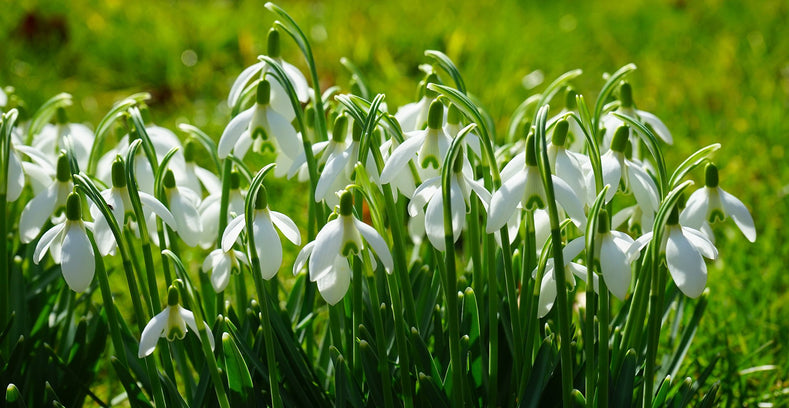At the end of winter the garden begins to wake up and one of its greatest pleasures is the appearance of tiny bulbs that seem to spring out of the ground against all odds. Many of these very early bulbs are adapted to woodland conditions such as cyclamens, snowdrops and winter aconites. Free from the shade of a leaf canopy and supplied with adequate moisture, they eagerly rush to complete their precocious growth cycles.
In established gardens wide drifts of Cyclamen coum may be found that have developed over many years spreading themselves freely by seed. They begin to flower in winter and continue well into spring in the same conditions that we might choose to introduce snowdrops, winter aconites and anemones.

Garden planting design is all about bringing plants together that grow in the same conditions and that are capable of developing a stable plant community together. For impact in our gardens they need to be used in sufficient numbers to draw attention to themselves. This is why the most memorable images of very early flowering bulbs are to be found in parks and large gardens where wide drifts of these small bulbs have naturalised and carpet the landscape.
In our own gardens the scale may be different but we should not be timid. Plant generously and develop a pattern of intertwining drifts and pools of the different species and varieties available. Also, be sure to place such schemes in parts of your garden where they may be easily seen in winter: near paths, entrances and perhaps through the windows of your home.
As winter moves into early spring different species of bulbs come into flower. The cyclamens may already be busy throwing up their tiny pink flowers to form strong pools of ground-hugging colour. If not, no worry, a trip to the garden centre will guarantee their arrival in flower at the time you need them.

In my mind winter is coming to an end when I see the first yellow, chalice-shaped flowers of Eranthis hyemalis opening on days when the sunshine cuts through the branches of any overhanging trees. Carpets of the happy yellow flowers of winter aconites around the edges of shrubs and under hedges are guaranteed to lift your spirits. Shortly thereafter the winter aconites will be joined by the real stars of the season, the snowdrops.
Galanthus elwesii is the native snowdrop and whilst it might not be as large and bold as any of the exotic Galanthus nivalis cultivars, in my opinion, it is the best for the boldest of naturalistic garden effects. Galanthus snowdrops grow easily in short grass and with diligence and a little effort, their spread can be quickly encouraged. By allowing them to set seed and also through dividing and replanting, their clumps can be spread wider year on year.

Blue flowers are common throughout the assortment of early flowering bulbs. One of the earliest is Scilla siberica which is ideal for planting in small clumps around the edges of drifts of Galanthus snowdrops.
Scilla mischtschenkoana ‘Tubergeniana’ has sparkling white flowers with an ice blue line down the centre of each petal. In the garden landscape it stands out boldly and is ideal making cool pools of colour around the bases of any trees and shrubs.
Glory of the Snow, Chionodoxa lucilea, never seems to live up to its name as it flowers slightly later when the chance of snow, certainly these days, has long past. This is an easy species that is available in a range of pastel blue and pink shades that needs to be planted in large numbers for a bold effect. It is reliable and will spread year on year. Definitely one to be added to the mixed carpet of bulbs we might create for this time of the year.
Towards the end of winter and the beginning of spring a new group of low-growing bulbs is ready to take centre stage. Tulips and daffodils in combinations with crocus, grape hyacinths and anemones will be the lead characters of our spring gardens, by which time the small jewel-like flowers of winter flowering bulbs will remain as a fond memory to be looked forward to next time around.
Michael King 10/2020
Michael King is a botanist, formerly Secretary to the Board of Trustees at Kew Gardens who has been living for the past twenty five years in Amsterdam, close to the bulb fields of Holland. A designer, tutor and garden writer, Michael is the author of magazine articles and numerous books on plants and gardens with particular reference to planting design using perennials and bulbs. He is a recognised expert on, above all, ornamental grasses and tulips.

